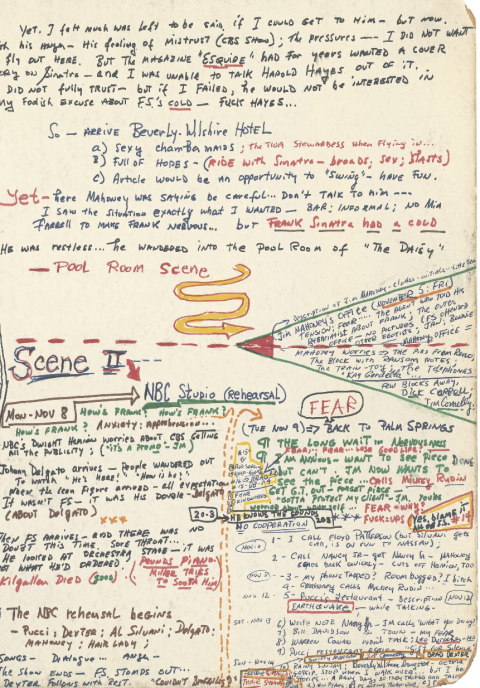Click image once to enlarge, and yet again to enlarge further.
The assignment was impossible: a subject that refused to be interviewed, research that took over three months, and expenses that reached nearly $5,000 (in mid 1960s money). The result: one of the greatest celebrity profiles ever written.
Recently hired by Esquire after spending the first ten years of his career at The New York Times, Gay Talese’s first assignment from editor Harold Hayes was to write a profile of the already iconic Frank Sinatra.
According to Esquire:
The legendary singer was approaching fifty, under the weather, out of sorts, and unwilling to be interviewed. So Talese remained in L.A., hoping Sinatra might recover and reconsider, and he began talking to many of the people around Sinatra — his friends, his associates, his family, his countless hangers-on — and observing the man himself wherever he could.
In an interview last month with Nieman Storyboard, Talese explained that he didn’t want to write the story in the first place. “Life magazine just did a piece on Sinatra,” he recalls. “What can you say about Sinatra that hasn’t already been said?” However, for a writer who has written many brilliant pieces, the resulting profile, “Frank Sinatra Has a Cold,” is his most indelible.
Above is Talese’s outline for the profile. Instead of notebooks, Talese used shirt boards to write down his observations. As he told The Paris Review in 2009, “I cut the shirt board into four parts and I cut the corners into round edges, so that they [could] fit in my pocket. I also use full shirt boards when I’m writing my outlines.”
What is also vital to Talese’s process is his personal observation. If you read Talese’s outline (click on the image above to enlarge), you will uncover more of what Talese thought and felt during that day than facts about Sinatra. “What I’m doing as a researching writer is always mixed up with what I’m feeling while doing it,” Talese notes, “and I keep a record of this. I’m always part of the assignment.”
This style goes to the heart of what became known as New Journalism, which, among other things, established the right for a writer to use his or her imagination to make a scene come alive. While the style was adopted by Talese, along with Tom Wolfe, Joan Didion, and others, it was first born out of necessity to complete the Sinatra profile. “The creativity in journalism is in what you do with what you have,” Talese says.
Related Content:
Gay Talese: Drinking at New York Times Put Mad Men to Shame
The Ten Best American Essays Since 1950, According to Robert Atwan
Watch Frank Sinatra Play “Snarling Mad Dog Killer” in 1954 Noir Suddenly


